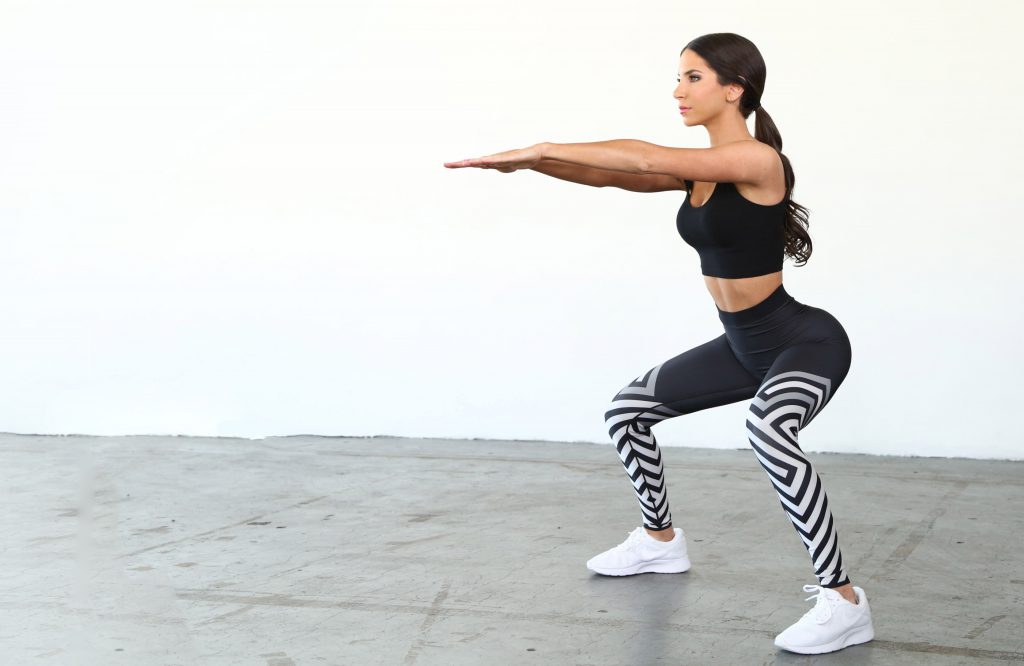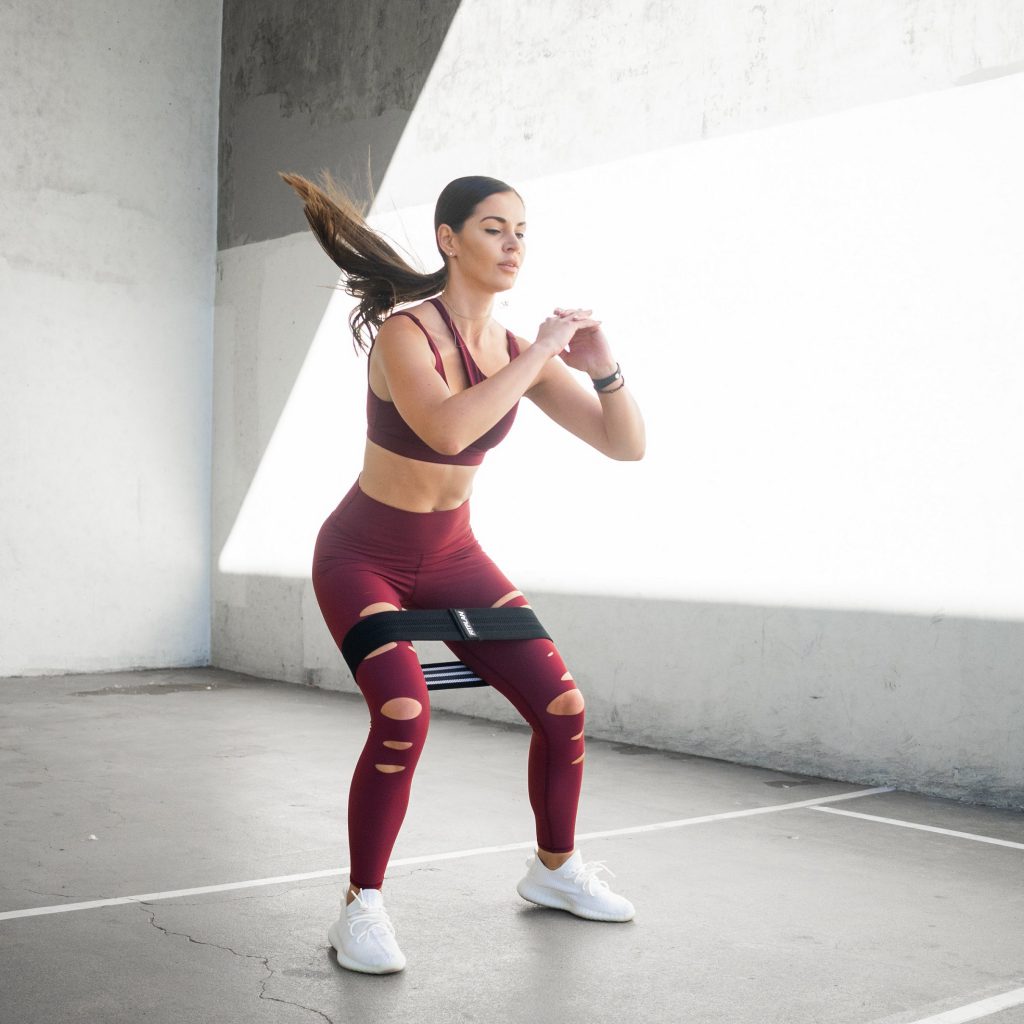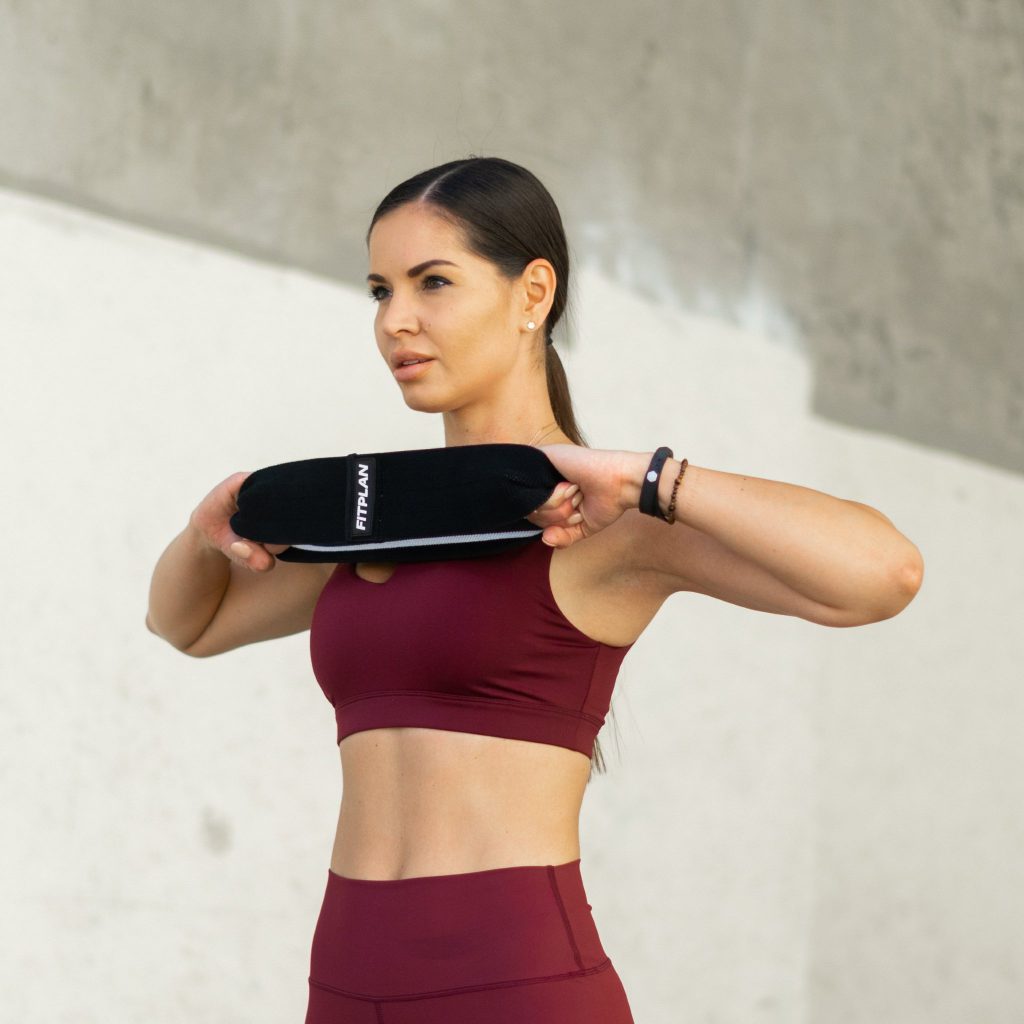Resistance bands create more muscle activation during strength training and bodyweight exercises. Muscles are put under more strain throughout their full range of motion which increases hypertrophy, leading to increased muscle mass.
Traditional squats are already great for building strong lower-body muscles. Add a resistance band to the equation and you’ll get an even more intense lower-body workout.
If you haven’t yet incorporated a resistance band into your bodyweight workouts, you can use this guide to find a few great warm-up exercises, the proper method for executing resistance band squats, and 5 variations to change up your routine.
(Note: Want our elite trainers to help you make the most of your resistance bands? Start your Fitplan free trial today!)
What Muscles Do Squats Work?
Regular squats cause muscle activation primarily in the glutes, quadriceps, and hamstrings. Besides these muscle groups in your butt and thighs, squats also work the calves, hip flexors, and hip abductor muscles in your groin.
Core muscles such as the obliques and erector spinae are also used. Although the lowest position of a standard squat might not seem like a common movement in everyday life, the entire movement is a great way to build functional strength in your lower body. That will improve your athletic performance, reduce your risk of injury, and make daily functions easier.

How to Perform a Traditional Squat
Normal squats aren’t very complicated but you can severely limit their effectiveness if you do them without the proper form. Follow these steps for perfect form when you’re doing squats:
- Start with your feet shoulder-width apart or slightly wider.
- Lean back so your weight moves onto your heels. Make sure your abdominals and other core muscles are engaged and keep your chest facing ahead of you as if you were trying to show off the front of your shirt.
- Continue lowering your torso and push your butt back and out as if you were about to sit down in a chair.
- When your thighs are parallel to the floor and your knees form 90-degree angles, you’ve reached the lowest point in the squat position. Your thighs and glute muscles should be feeling the pain a bit.
- For most people, the knees will be over the toes without passing them. If you have long legs, your knees may have to move past the toes somewhat.
- Push through your heels and rise back to the starting position.
You can put your hands out in front of your body for additional balance or you can place them at your sides. Incorporate your upper body by holding dumbbells or a kettlebell during your squat reps.
Make sure your spine remains neutral. Try to bring your lower back directly down to the floor rather than leaning your torso forward. Don’t clench your muscles too much to try and accomplish this, though. All you need to do is engage your core and abdominal muscles.
Helpful Hint: Learn more bodyweight exercises to build your squat strength with our HOME Active Fitplan!
Banded Squats: How To & Benefits
Generally, the resistance band should be wrapped around your legs above the knee when you are performing banded squats. The movement is otherwise the same as a traditional squat. A loop band is the easiest to use for squats because you can wrap it around your legs comfortably without having to tie a knot.
As you lower your torso to the ground, your thighs will naturally get further apart. The resistance band will keep pressure on your inner thighs, making the muscles there work harder. Not only will this burn more calories, but it will also help build more strength and muscle mass in your legs.
Resistance bands come in varying degrees of resistance, which is measured in pounds. Just like a rubber band, the more you stretch a resistance band, the more tension it has. All this tension puts pressure on your muscles throughout the full range of motion of an exercise.
Using a resistance band to do basic body weight squats also help build up strength to do more complicated squat variations that use additional weight from a barbell, dumbbells, or kettlebells. Most importantly, adding a resistance band to your squat will help you maintain proper form throughout your squat.
5 Variations of the Banded Squat Exercise
Whether you’re trying to shred fat, increase your squat strength, or build muscle mass, you’ll have to push your muscles to exhaustion and maintain interest throughout your workout routine. These banded squat exercises are excellent for both purposes and they also promote the activation of peripheral muscles that standard squats don’t hit.
1. Banded Split Squat
Don’t worry, you don’t have to do a split to perform this move. They call it a split squat because your feet won’t be together like they are during a traditional squat.
You’ll need a loop band for banded split squats. Start in a standing position and let the loop band down to the floor while keeping hold of one end with both hands. Take a step forward with your right leg and step on the opposite end of the loop band.
The position this leaves you in is similar to where you’d be about halfway through a lunge. Just like lunges, you’re going to bend your knees so that your torso moves toward the ground. Both knees should be at a 90-degree angle.
Push up through your right foot to get back to the starting position. Complete all your reps with your right leg out front before switching to your left leg.
Not only will this single-leg banded squat variant help build muscle better in each leg, but it will also increase your balancing ability. Using this variation will bring your triceps, shoulders, and calves into the mix.
Helfpul Hint: Learn more great exercises with banded variations in our Bodyweight Burner Max Fitplan!

2. Banded Jump Squats
Target your quadriceps and add some explosive cardio with the plyometric jump in this squat variation. To perform this move, you’ll wrap a loop band around your legs above the knee just like you would for the traditional banded squat.
The squat motion in this variation is basically the same as a normal squat, but the additional jump will lead to more muscle activation in your glutes and hamstrings. Many people who are worried about cardio ruining their gains use plyometric exercises like this one to get the advantages of cardio without burning so many calories that their body doesn’t have enough energy left over to build muscle.
In a standing position with your feet shoulder-width apart and a loop band just above your knees, begin to lower yourself into a squat position. For this plyometric variation, it will probably help to keep your arms out in front of you.
Squat until your legs are at a 90-degree angle, but instead of simply rising back to the starting position, explode through your heels so that you jump high enough to leave the ground. Land softly back on the ground in a standing position to complete one rep.
3. Banded Sumo Squat
If you’re trying to build a big booty, try sumo squats. They’re one of the best leg exercises for bigger and stronger glutes. The main difference between banded sumo squats and regular banded squats is your stance – your legs will be further apart.
That distance helps work out your hips, glutes, hamstrings, inner thighs, quadriceps, and calves. Like many other squat variations, you can hold weight in your arms to make sumo squats challenge your whole body. Because the difference in stance between a sumo squat and a normal squat is fairly slight, it’s easy to swap between one and the other in a HIIT routine.
Wrap the resistance band around your legs above the knee. Place your feet more than hip-width apart and make a V shape by angling your feet outward. Bend your knees to get into the squat position and stop when your thighs are parallel to the ground.
Squeeze your glutes at the bottom of the move, then drive through your heels to rise back to the starting position. Be mindful that your torso doesn’t lean forward during the squat. Try to bring your lower back and tailbone straight down toward the floor and keep your back neutral throughout the move.
4. Squat Crab Walk
Lateral motion in this crab walk exercise adds a new dimension to your squat routine. Even though you’ll only be in a half-squat position rather than lowering your torso all the way down like you would in a normal squat, the sustained position and particular motion make this a full-body workout.
Your glutes, hamstrings, quads, and core will all be challenged by this move. If you want, you can try holding weights to give your body a harder workout. This is also a great move for people who find that getting into the low full-squat position causes pain in their knees or other joints.
Place the resistance band around your legs above the knee and then begin to get into the squat position. Stop when your thighs are between a 15 – 45° angle, depending on what’s most comfortable. The lower you get, the more strain will be on your muscles, but it could also make it hard to do the walk.
Once you’re in the half-squat position, you lift your hands out in front of you. If you want, make a fist with both hands. Take one step out with your right foot and then follow that motion with the left foot.
You can continue walking like this for 10 – 15 steps. If you don’t have room, step back and forth instead.
5. Banded Goblet Squat
For a better full-body workout, this banded squat is ideal. Many people choose to wrap the band around their legs above the knee and hold a kettlebell or dumbells in their hands, but you can also use the band in a different way to make this a hugely effective bodyweight exercise.
Step on the bottom of a resistance band and take the opposite side in your hands so that the band is more or less in the shape of a triangle. Keep your hands together and in front of your chest. If you have a large loop band, you can grip the opposite end of the resistance band with your palms facing up, kind of like you would do if you were holding a barbell up by your shoulders.
Once you have to resistance band in place, lower your torso into the squat position. Make sure your spine stays neutral and you stop when your thighs are parallel with the floor. Push through your feet to get back into the starting position.
Helpful Hint: Get a world-class body with the exercises in our A-Rod Fit Fitplan!
How to Intensify Your Squats
Some people consider the following methods to be completely separate squat variations in their own right, but since you can add them to any of the 5 squat variations we’ve just been over, we’ll discuss them as strategies to make your squats more challenging and effective.
Like any other exercise routine, you can make your squats more difficult by adding weight, reducing rest time, or adding in whole new movements altogether. Most people who don’t want to leave their arms out entirely come leg day hold free weights, kettlebells, barbells, or other types of weights to make their squats engage their muscles even more.
HIIT routines with shortened rest periods are gaining popularity, but you can also reduce the amount of time in the sections of your squats where your muscles are under the least amount of stress. Rather than returning all the way to the starting position in any squat variation, you can rise about two-thirds of the way and then go right back into the lowest squat position. This method is called a pulse squat.
One common movement people add to their squats is a lateral leg lift. It’s exactly what it sounds like: you lift one leg out to the side as high as you can bring it. This gets more unique muscle activity and makes the squat more dynamic.
You can add this to your squats at the moment when you get back to the starting position. When you’re standing straight again, lift your leg and then return it to the ground before completing another squat. Make sure you do equal numbers of leg lifts on your left and right legs to develop the same amount of muscle and strength on each side of your body.
Another movement you can consider adding to your squats is an overhead stretch. It’s not a whole new movement the way a lateral leg lift is. Throughout the squat, you can hold dumbbells or a similar kind of weight over your head with your arms fully outstretched to give your arms muscles a better workout. This will also improve the coordination between your upper and lower body.

Resistance Band Training Vs Conventional Lifting
Studies have confirmed that banded resistance training is just as effective as lifting conventional weights. That’s great news for anyone who wants a lightweight, compact, and inexpensive way to exercise outside the gym without having to invest in large and costly home gym machines or weights. You can even pack a band in an overnight bag, briefcase, or purse and tackle your routine wherever is most convenient.
That being said, if you’re really trying to build some massive muscles, the best thing you can do is to combine resistance bands with your conventional lifting. Just like the bands increase the effectiveness of your squats, they’ll also create more muscle activation during other lifting moves.
Once you get really good at squats, you can bring in weights and combine them with resistance bands to really push your body to the limits. It’s one of the best ways to make your leg day even more widely effective at building muscles and strength all over your body. The overhead stretch movement is a perfect way to add weight to your banded squat routine without fundamentally changing the movement.
Helpful Hint: Build your squat strength with the Natural Body Contour Fitplan!
Conclusion:
Resistance bands create tension in muscles throughout the full range of motion of an exercise. Without them, there are large sections of movement where there is little to no pressure on the muscles. This is especially true when it comes to classic bodyweight exercises like squats.
Banded squats not only make the exercise way more effective at building muscle and functional strength, but they also help keep your leg day routine entertaining. The variations in this guide should help break up your day at the gym and target your muscles in new and unique ways so that they don’t adjust to the workout.
Mastering the proper form for squats can be a bit challenging, but the resistance band will help correct your stance and prevent mistakes. If you’re trying to build strength for bigger moves like deadlifts or pull-ups, banded squats are a great way to do it. The variations mentioned in this guide will create more well-rounded strength to prepare your body for anything.
(Note: Want our elite trainers to help you perfect your squat? Start your Fitplan free trial today!)


